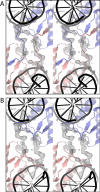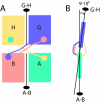Domain swapping in allosteric modulation of DNA specificity
- PMID: 21151881
- PMCID: PMC2998434
- DOI: 10.1371/journal.pbio.1000554
Domain swapping in allosteric modulation of DNA specificity
Abstract
SgrAI is a type IIF restriction endonuclease that cuts an unusually long recognition sequence and exhibits allosteric self-modulation of cleavage activity and sequence specificity. Previous studies have shown that DNA bound dimers of SgrAI oligomerize into an activated form with higher DNA cleavage rates, although previously determined crystal structures of SgrAI bound to DNA show only the DNA bound dimer. A new crystal structure of the type II restriction endonuclease SgrAI bound to DNA and Ca(2+) is now presented, which shows the close association of two DNA bound SgrAI dimers. This tetrameric form is unlike those of the homologous enzymes Cfr10I and NgoMIV and is formed by the swapping of the amino-terminal 24 amino acid residues. Two mutations predicted to destabilize the swapped form of SgrAI, P27W and P27G, have been made and shown to eliminate both the oligomerization of the DNA bound SgrAI dimers as well as the allosteric stimulation of DNA cleavage by SgrAI. A mechanism involving domain swapping is proposed to explain the unusual allosteric properties of SgrAI via association of the domain swapped tetramer of SgrAI bound to DNA into higher order oligomers.
Conflict of interest statement
The authors have declared that no competing interests exist.
Figures






Similar articles
-
Structural analysis of activated SgrAI-DNA oligomers using ion mobility mass spectrometry.Biochemistry. 2013 Jun 25;52(25):4373-81. doi: 10.1021/bi3013214. Epub 2013 Jun 17. Biochemistry. 2013. PMID: 23742104 Free PMC article.
-
New clues in the allosteric activation of DNA cleavage by SgrAI: structures of SgrAI bound to cleaved primary-site DNA and uncleaved secondary-site DNA.Acta Crystallogr D Biol Crystallogr. 2011 Jan;67(Pt 1):67-74. doi: 10.1107/S0907444910047785. Epub 2010 Dec 16. Acta Crystallogr D Biol Crystallogr. 2011. PMID: 21206063 Free PMC article.
-
Activation of DNA cleavage by oligomerization of DNA-bound SgrAI.Biochemistry. 2010 Oct 19;49(41):8818-30. doi: 10.1021/bi100557v. Biochemistry. 2010. PMID: 20836535 Free PMC article.
-
The structure of SgrAI bound to DNA; recognition of an 8 base pair target.Nucleic Acids Res. 2008 Sep;36(16):5405-16. doi: 10.1093/nar/gkn510. Epub 2008 Aug 13. Nucleic Acids Res. 2008. PMID: 18701646 Free PMC article.
-
Structures, mechanisms, and kinetic advantages of the SgrAI filament forming mechanism.Crit Rev Biochem Mol Biol. 2024 Dec;59(6):363-401. doi: 10.1080/10409238.2024.2440315. Epub 2024 Dec 19. Crit Rev Biochem Mol Biol. 2024. PMID: 39699272 Review.
Cited by
-
Structural analysis of activated SgrAI-DNA oligomers using ion mobility mass spectrometry.Biochemistry. 2013 Jun 25;52(25):4373-81. doi: 10.1021/bi3013214. Epub 2013 Jun 17. Biochemistry. 2013. PMID: 23742104 Free PMC article.
-
Probing the run-on oligomer of activated SgrAI bound to DNA.PLoS One. 2015 Apr 16;10(4):e0124783. doi: 10.1371/journal.pone.0124783. eCollection 2015. PLoS One. 2015. PMID: 25880668 Free PMC article.
-
Allosteric regulation of DNA cleavage and sequence-specificity through run-on oligomerization.Structure. 2013 Oct 8;21(10):1848-58. doi: 10.1016/j.str.2013.08.012. Epub 2013 Sep 19. Structure. 2013. PMID: 24055317 Free PMC article.
-
New clues in the allosteric activation of DNA cleavage by SgrAI: structures of SgrAI bound to cleaved primary-site DNA and uncleaved secondary-site DNA.Acta Crystallogr D Biol Crystallogr. 2011 Jan;67(Pt 1):67-74. doi: 10.1107/S0907444910047785. Epub 2010 Dec 16. Acta Crystallogr D Biol Crystallogr. 2011. PMID: 21206063 Free PMC article.
-
Three-Dimensional Domain Swapping Changes the Folding Mechanism of the Forkhead Domain of FoxP1.Biophys J. 2016 Jun 7;110(11):2349-2360. doi: 10.1016/j.bpj.2016.04.043. Biophys J. 2016. PMID: 27276253 Free PMC article.
References
Publication types
MeSH terms
Substances
Associated data
- Actions
Grants and funding
LinkOut - more resources
Full Text Sources
Molecular Biology Databases
Miscellaneous

